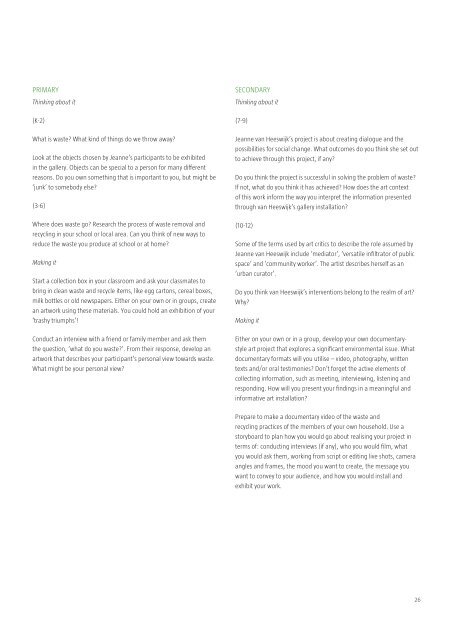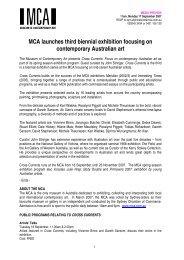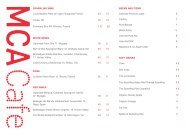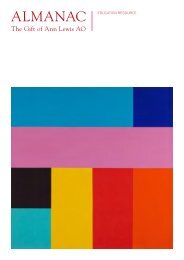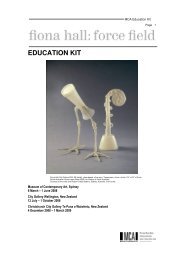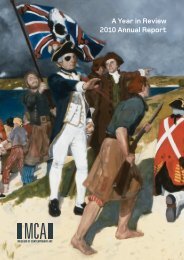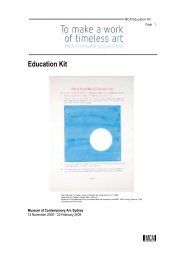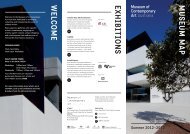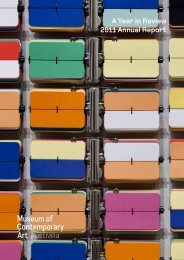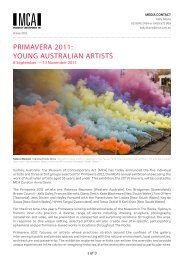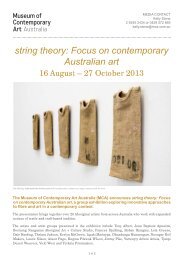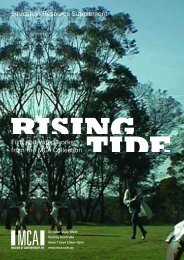Download - Museum of Contemporary Art
Download - Museum of Contemporary Art
Download - Museum of Contemporary Art
You also want an ePaper? Increase the reach of your titles
YUMPU automatically turns print PDFs into web optimized ePapers that Google loves.
PRIMARY<br />
Thinking about it<br />
(K-2)<br />
What is waste What kind <strong>of</strong> things do we throw away<br />
Look at the objects chosen by Jeanne’s participants to be exhibited<br />
in the gallery. Objects can be special to a person for many different<br />
reasons. Do you own something that is important to you, but might be<br />
‘junk’ to somebody else<br />
(3-6)<br />
Where does waste go Research the process <strong>of</strong> waste removal and<br />
recycling in your school or local area. Can you think <strong>of</strong> new ways to<br />
reduce the waste you produce at school or at home<br />
Making it<br />
Start a collection box in your classroom and ask your classmates to<br />
bring in clean waste and recycle items, like egg cartons, cereal boxes,<br />
milk bottles or old newspapers. Either on your own or in groups, create<br />
an artwork using these materials. You could hold an exhibition <strong>of</strong> your<br />
‘trashy triumphs’!<br />
Conduct an interview with a friend or family member and ask them<br />
the question, ‘what do you waste’. From their response, develop an<br />
artwork that describes your participant’s personal view towards waste.<br />
What might be your personal view<br />
SECONDARY<br />
Thinking about it<br />
(7-9)<br />
Jeanne van Heeswijk’s project is about creating dialogue and the<br />
possibilities for social change. What outcomes do you think she set out<br />
to achieve through this project, if any<br />
Do you think the project is successful in solving the problem <strong>of</strong> waste<br />
If not, what do you think it has achieved How does the art context<br />
<strong>of</strong> this work inform the way you interpret the information presented<br />
through van Heeswijk’s gallery installation<br />
(10-12)<br />
Some <strong>of</strong> the terms used by art critics to describe the role assumed by<br />
Jeanne van Heeswijk include ‘mediator’, ‘versatile infiltrator <strong>of</strong> public<br />
space’ and ‘community worker’. The artist describes herself as an<br />
‘urban curator’.<br />
Do you think van Heeswijk’s interventions belong to the realm <strong>of</strong> art<br />
Why<br />
Making it<br />
Either on your own or in a group, develop your own documentarystyle<br />
art project that explores a significant environmental issue. What<br />
documentary formats will you utilise – video, photography, written<br />
texts and/or oral testimonies Don’t forget the active elements <strong>of</strong><br />
collecting information, such as meeting, interviewing, listening and<br />
responding. How will you present your findings in a meaningful and<br />
informative art installation<br />
Prepare to make a documentary video <strong>of</strong> the waste and<br />
recycling practices <strong>of</strong> the members <strong>of</strong> your own household. Use a<br />
storyboard to plan how you would go about realising your project in<br />
terms <strong>of</strong>: conducting interviews (if any), who you would film, what<br />
you would ask them, working from script or editing live shots, camera<br />
angles and frames, the mood you want to create, the message you<br />
want to convey to your audience, and how you would install and<br />
exhibit your work.<br />
26


